
The M1A1 Thompson was the streamlined military version. My buddy carried a gun like this one throughout most of his time as a combat Infantryman in Europe during World War 2.
The war in Europe had less than a week to go before it finally sputtered and died. Everybody on both sides knew it was over. An American Infantry unit drew up into defensive positions short of a German river to wait it out. Nobody much wanted to be the last casualty of the Second World War in Europe.
The mission was to snatch German prisoners for interrogation. At least that was the briefing. The real mission was to let a new Lieutenant lead a combat patrol before the war ended. It was felt that he would need the experience if he hoped to be successful in an Army full of combat veterans.
My buddy knew war. He was still young according to his birth certificate, but war ages a man. He carried a Thompson submachine gun, and he knew how to run it.
He had traded his M1 rifle to a 37mm anti-tank gunner for the Thompson before a night patrol months prior and just never gave it back. The 37mm was worthless against the sorts of armor the krauts fielded by then anyway. That guy’s war was done.
The Thompson came with five 20-round box magazines but no web gear. My friend carried the spare magazines along with several boxes of loose .45ACP ammo in the pockets of his field jacket. He told me that every time he had a lull in combat he would drop down behind a tree and thumb fresh rounds into a magazine. He also told me there were many practical benefits to carrying both a long gun and a handgun that ran the same ammunition.
The patrol pushed into the nearby town and bagged their two prisoners without undue difficulty. The Germans were as sick of the war as were the Allies. As they staged behind a large building everybody wanted to head back but the patrol leader. The Lieutenant felt they should push a little bit farther into the town and see what they could find out.
With the utmost reluctance a veteran who had served with my buddy since they hit the beaches took point. My friend tried to stop him as he stepped around the corner. For his trouble, the man got a burst of 9mm to the chest from a German MP40. He remained standing, stunned by the event. My friend stepped around behind him and killed the German soldier with a burst from his Thompson. He told me that the Tommy gun was sinfully heavy, but that it was literally unstoppable in the close fight.
The patrol retreated into a nearby building. The wounded point man followed right behind. He then dropped to the floor, bled out, and died. After a moment’s indecision, the rest of the patrol pressed out the back of the house with the two captured Germans in the lead. The two captives triggered a tripwire and died when a German antipersonnel mine detonated in the backyard. My buddy then killed another German soldier with an automatic weapon who had been covering the mined lane. The patrol subsequently made it back across the river without further incident.
The whole sordid mess was just a nameless little engagement swallowed up by an ocean of death, but it cost the lives of a seasoned American infantryman as well as four German soldiers. The unfiltered futility of the thing was enough to give my friend pause when he related it to me some seventy years later. The Lieutenant got his patrol, and my friend traveled all the way across the country to visit the dead man’s family after he got home. He never told them the details.
The Thompson Submachine Gun

The Thompson submachine gun was respected on both sides of the line. Here we see German Fallschirmjagers inspecting an early captured M1928.
John Taliaferro (pronounced “Tolliver”) Thompson was a respected ordnance officer throughout a distinguished career in the United States Army. During the Spanish-American War he was the youngest Colonel in the Army. John Thompson supervised the development of the M1903 Springfield rifle and served as chairman of the ordnance board that approved the 1911 pistol. As part of that process, he had the competing weapons fired at live cattle and human cadavers to assess the effectiveness of the new .45ACP round.
Thompson retired in 1914 to take a job with Remington. He came back on active duty in 1917 as a Brigadier General supervising all World War 1 small arms production for the Army. Military firearms of the period sporting the acceptance stamp “J.T.T.” were inspected by General Thompson.
Throughout this time Thompson worked on what he called his Trench Broom. This handheld automatic gun was to fire pistol-caliber rounds and be serviced by a single soldier. He envisioned the weapon as a tool capable of sweeping the trenches clean of enemy soldiers. World War 1 ended before the gun was ready for production.
Again a civilian, Thompson threw his energy into perfecting the design of his eponymous Thompson submachine gun and marketing it to military, civilian, and Law Enforcement buyers. While the gangsters of the Great Depression got all the press, they actually used a relatively small number of his guns. The earliest M1921 Thompsons were contracted out to Colt for production and were things of beauty. Subsequent M1928 models run a little slower but remain morphologically very similar.
Peacetime sales were slow, and Thompson was ultimately removed as head of the Auto-Ordnance Corporation. He died in June of 1940 and was buried on the grounds of the US Military Academy. World War 2 began the following year, and the world’s appetite for Thompson guns became insatiable.
A simplified version of the Thompson gun titled the M1 and subsequent M1A1 shaved a bit off the cost while slightly increasing the rate of fire. A glance at the actuator is the quickest way to tell the two main variants apart. M1921 and M1928 versions have their actuators on the top. M1 and M1A1 variants have their actuators on the right side. The government produced more than 1.5 million Thompson submachine guns by the end of World War 2. The last Thompson left the US military inventory in 1971. General Thompson never saw any of it.
Trigger Time

The Thompson in all its guises is just ridiculously heavy. M1921/1928 versions were cut for 50 and 100-round drum magazines. With a loaded 100-round drum in place, the gun weighed more than 14 pounds. Later M1-series guns did not accept drums.
All military Thompsons fire from the open bolt. The morphology of the Thompson is convenient to carry but otherwise completely wrong. The line of recoil rides well above the buttstock and creates a vicious twisting moment that tends to translate into muzzle rise. The gun’s saving grace is its profound mass.
So long as you lean into the gun and put your body weight behind it the Thompson can be imminently controllable. Later M1A1 guns run surprisingly fast. In experienced hands, a .45ACP Thompson cycling at 800 rounds per minute can be breathtaking downrange. Having run a few I can see why my friend was so taken with his. I would just hate to have to carry it.
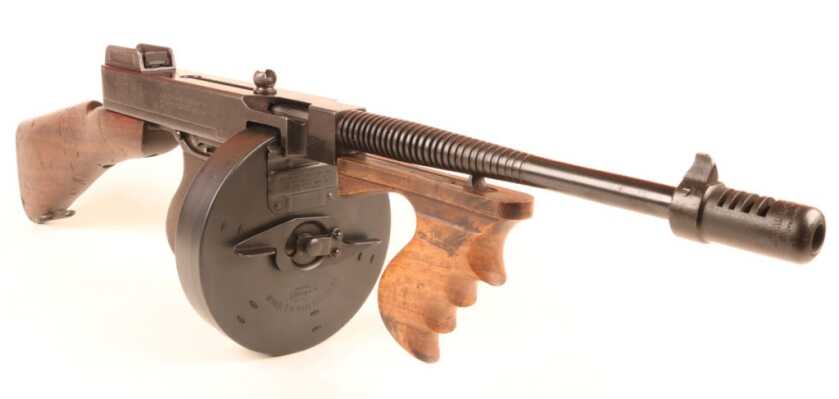
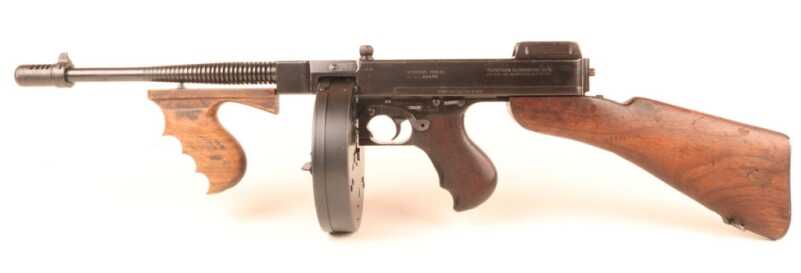
The M1928 was used by both American and Commonwealth forces early in the war. This variant is closely related to the M1921 guns used by gangsters during Prohibition.
The Thompson includes a last round bolt hold open device that locks the bolt to the rear over an empty magazine. To put the gun back in action you simply swap the magazines and squeeze the trigger. Nothing is faster, even today.
The safety and fire selector are two separate levers located on the left side above the pistol grip. Left-handed shooters are screwed, but they should be used to that by now. The rear switch is the safety. The forward switch is the fire selector.
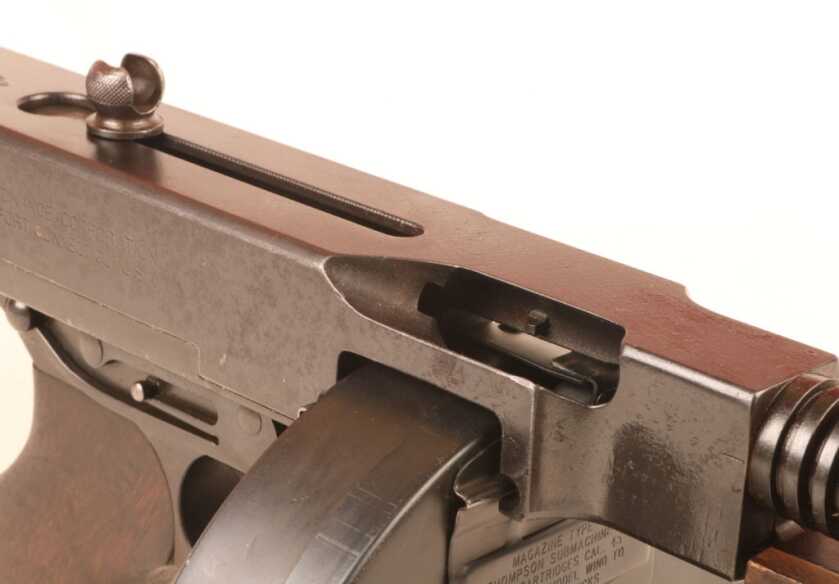
The Thompson runs very comfortably from the hip, but we don’t do that anymore. In the 1940’s, however, my buddy could shove the muzzle of his Thompson gun through a cracked doorway and fill an entire room with pain. There were no embedded reporters with video cameras back then. Box magazines come in 20 and 30-round varieties, and, as my buddy can attest, the stubby boxes were in use to the very end of the war.
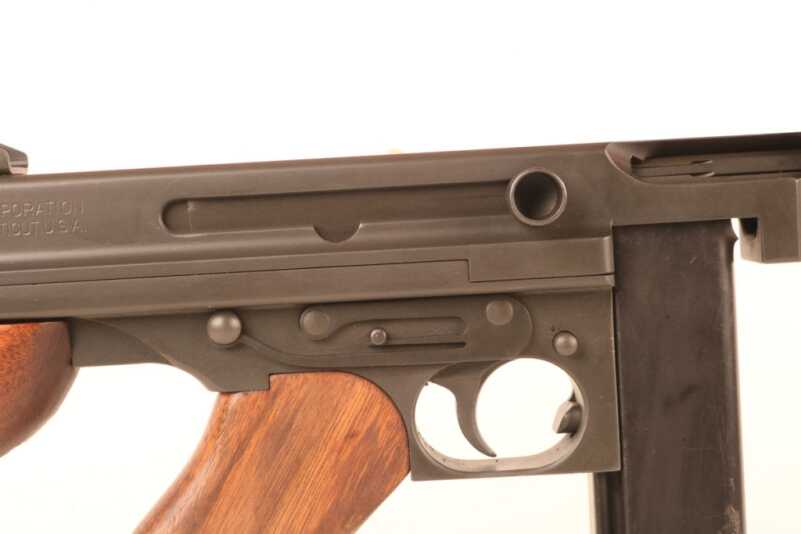
The quickest way to differentiate early versus late Thompsons is to note the position of the actuator. Early M1928 guns had their actuators on the top. Later M1-series weapons had this appendage on the right side.
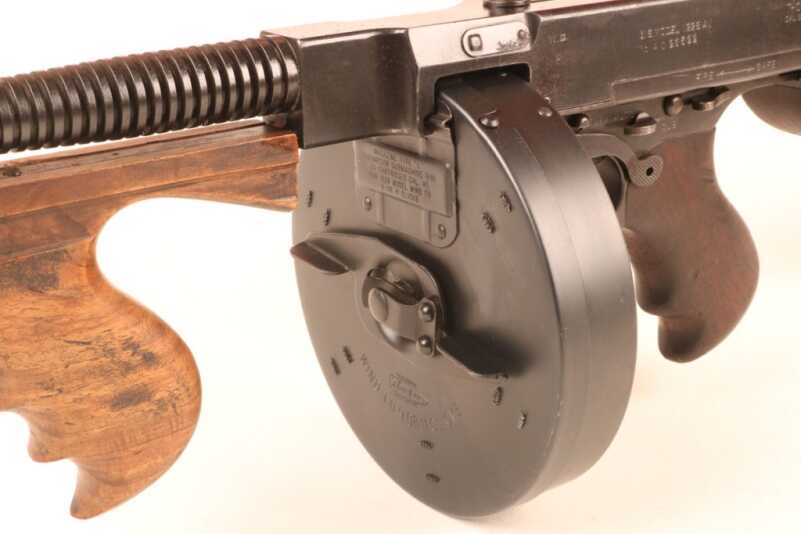
Early 1921 and 1928 Thompson guns were cut to accept drum magazines. Later M1-series Thompsons were not. Thompson drums were heavy, loud, and cumbersome.
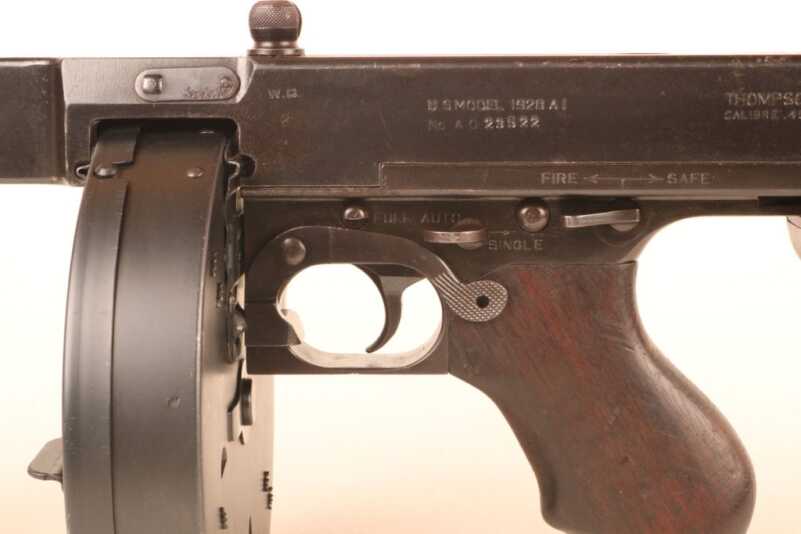
Very little was common between early and late Thompson guns. The M1928 sports much more refined accouterments.
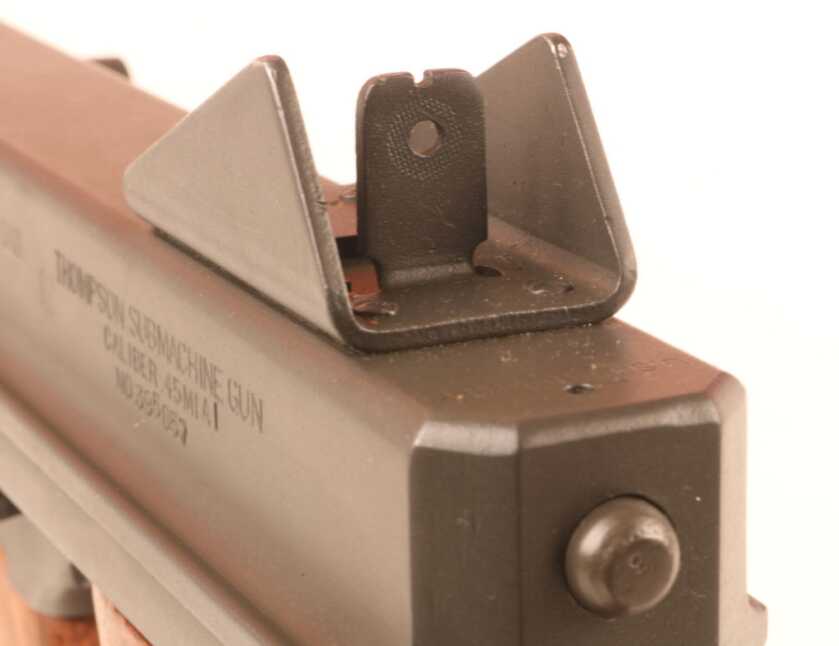
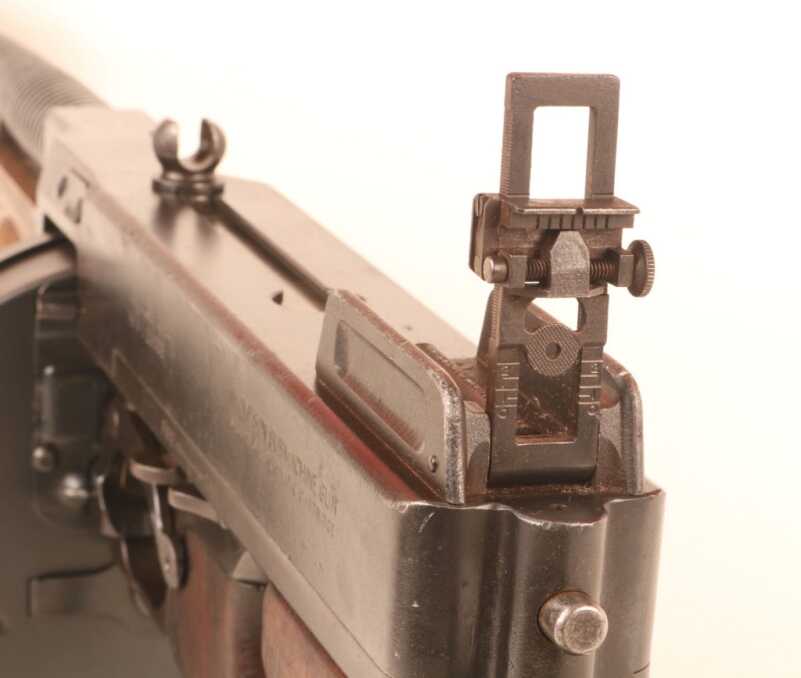
Later sights were simple strips of stamped steel. These sights can be found on both M1928 and M1 guns. Early Lyman sights were ridiculously complicated.
Denouement
My Thompson-toting friend is now well into his nineties. Even today he has no use for Germans. His opinion of young self-absorbed Army officers is not much better.
The Thompson was fully twice as heavy as the M16A1 rifle I carried when I wore the uniform, yet countless guys like my pal willingly carried theirs all the way across Western Europe. Part of that no doubt stemmed from James Cagney gangster films, but there yet remained something else. In this boat anchor-heavy submachine gun we find a remarkably effective combat tool. Despite its excessive weight and dated ergonomics, the Thompson submachine gun was an undeniably efficient killer of men.
Technical Specifications
Thompson Submachine Gun
Caliber: M1928 – .45ACP; .45ACP
Weight: M1928 – 10.8 lbs; M1A1 – 10 lbs
Length: M1928 – 33.7 in; M1A1 – 31.9 in
Barrel Length: M1928 – 12 in (w/compensator); M1A1 – 10.5 in
Cyclic Rate of Fire: M1928 – 600-725 rpm; M1A1 – 800 rpm
Feed System: M1928 – Box/Drum; M1A1 – Box
Special thanks to www.worldwarsupply.com for the period gear used to outfit our American paratrooper.
***Shop GunsAmerica for your next historic Thompson***

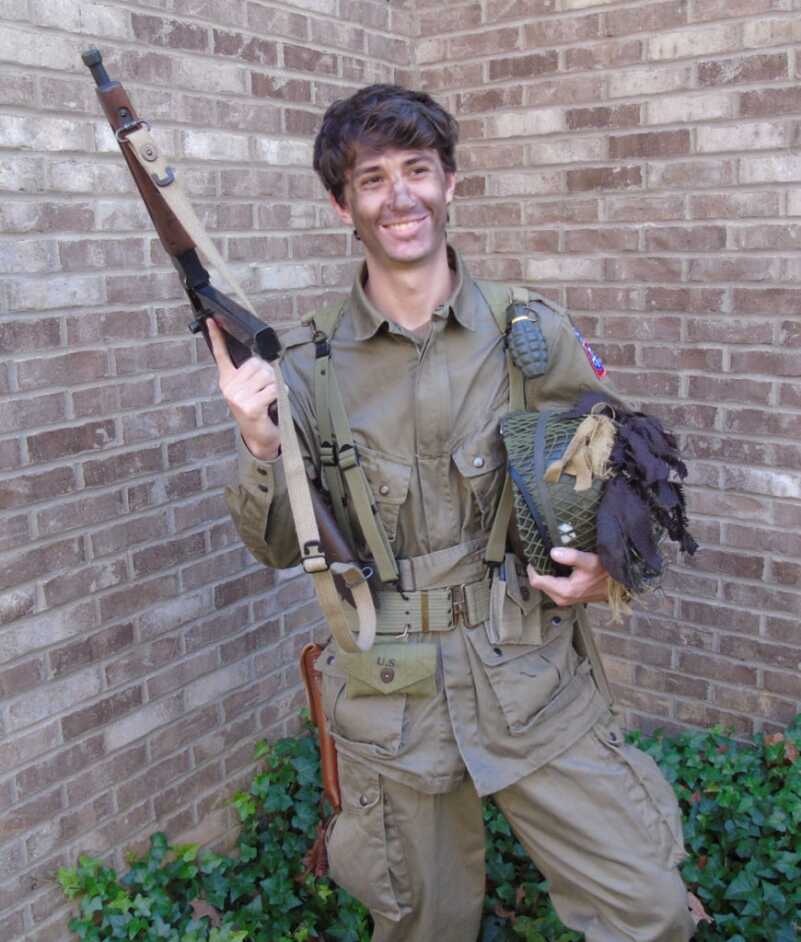
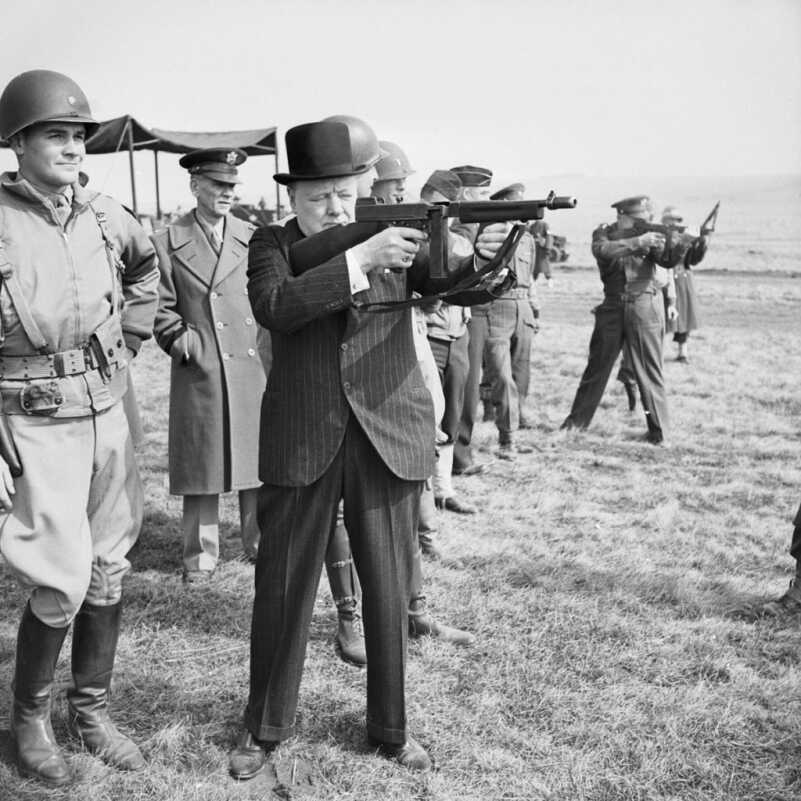

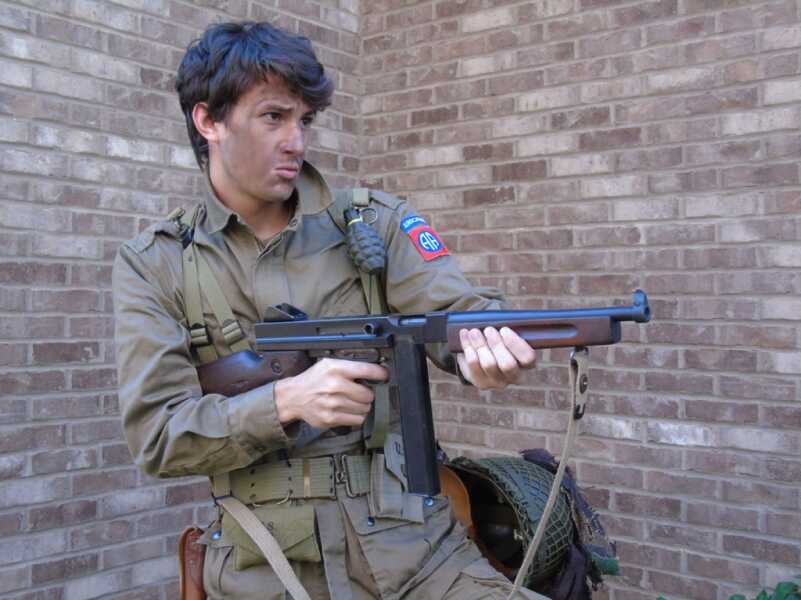
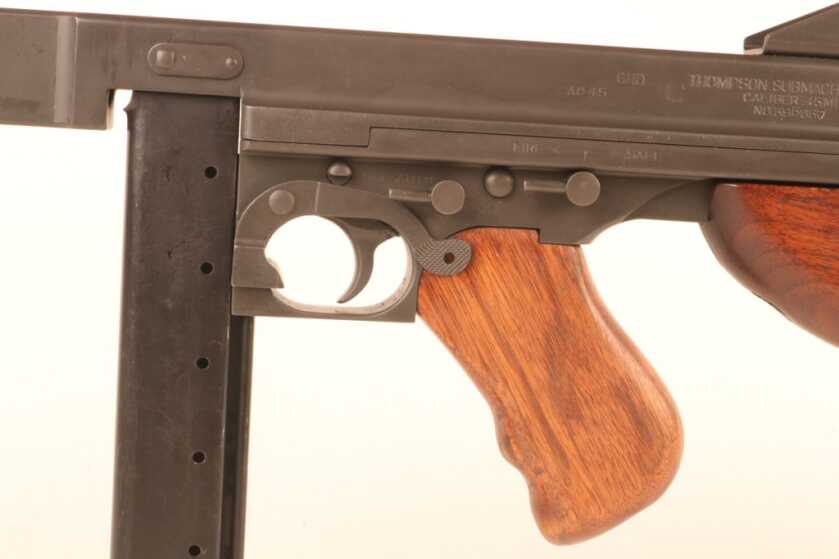

“The Thompson includes a last round bolt hold open device that locks the bolt to the rear over an empty magazine. To put the gun back in action you simply swap the magazines and squeeze the trigger. Nothing is faster, even today.”
No you still have to also rack the bolt all the way back to continue firing.
I own an M1A1 chambered in 4.5mm. Fun Gun!😁..See…..
https://www.youtube.com/shorts/g8imeUIOI8o
The Tommy M1A1 Version….the most bad ass looking gun ever made.
John Taliaferro (pronounced “Tolliver”) ?
Are you kidding ?
It’s pronounced just as it reads, NOT “Tolliver”.
It’s Italian for Cuts Steel.
That looks like Ike on the firing line behind Churchill.
Ike in the background firing the other Thompson.
Morphology?
You keep using that word. I do not think it means what you think it means.
Good article, Doc, and great photos, too !!! DMD
In 1969 I was assigned to an Army Advisor Team in TamKy, Vietnam, being in the air or the field on a daily basis I didn’t have much faith in my Marine Corps issued 1911A1, I asked if the Advisor Team could break lose a M16 for me, but they said they only have enough for their own people, since they were still having problems with the M16, but I could carry anything I could shoot! My Viet’s brought me two Thompson’s, both 1928 with the cocking lever on the top which you sighted through. With a case of ammo and another case of mags we went to the TamKy Airport to check them out….both garbage with numerous failures to feed due primarily to bad mags and OLD weapons! Decided to NOT put my life on the line by carrying these “paperweights”!
A week later they brought me two M3A1 “grease guns” with about 40 mags, back to the TamKy Airport and there I found that the mags were in better condition and after a thorough cleaning and some lube, both fired flawlessly, kept both and a few weeks later in Danang found that the Marine Corps 5th CIT Team had a case of Ithica silencers, but NO M3A1s…made a trade for one grease gun for a silencer and carried it for the next two years. The silencer balanced the weapon making it far more accurate to shoot and at night time all one could hear was the one pound bolt slamming back and forth. Turned out to be a nice 200 yard weapon from rice paddy to rice paddy and a GREAT brush cutter in double canopy! Found a home made mag carrier from the VC which carried 9 mags so with one in the weapon I always carried 300 rounds, yes HEAVY, but a really effective weapon for the terrain in which we worked! Having been trying for years to find another, especially with the Ithica silencer, but so far, NO luck!
Another great article, Doc!
Hope it’s a true story…sounds an awful lot like one of the closing episodes [9 I think, where Tom Hanks son Colon Hanks was the young Lt. fresh out of West Point] in the mini-series, “Band of Brothers”, in fact, un-canny in its resemblance. The 1911 .45 acp is my favorite hand gun so the Thompson is my favorite, fast talking, big brother. I hear tell the Germans were afraid of the, all too familiar, tat-tat-tat of the Thompson.
I find myself agreeing. It is uncannily similar. Hope it’s true though. I carried two 1928’s in my Corporal’s squad car when I was on duty during the holidays at a metro police department back in the ’70’s. Never got to use them, fire them or anything other than salivate over them every time I opened that locker in the back of the station wagon…haha
It happened just as described. The elderly gentleman related the story to me in the clinic one day out of the blue. He told me a couple of other Thompson stories I use someplace later as well.
Great article, Will! Your usual outstanding work. I see you have found a new model for your photos.
The German MP-38, MP40 and the Russian PPSh-41 and the PPS-43 were the sub MG’s that swept Europe. The heavily machined and loaded M1928 M1-A1 weighing 14 pounds and only having 20rd. magazines made it obsolete before it arrived. It takes good pictures in gun blog articles, though.
Our Thompsons were obsolete,? I didn’t know that. Is that why we lost the war, then?
R.Madillo, having the best weapons does not necessarily determine who will win a war. Japan swept the pacific in 1941-42 with pre-WWI designed bolt actions, marginally effective handguns, and no significant usage of submachine guns.
Winston’s point is that the Thompson was designed just after WWI, and by WWII it was showing its age. Stamped weapons could be made much cheaper and faster than the machined Thompson, and they were lighter to carry. No mistake, the Tommy Gun is super cool, and the .45 vs. 9mm debate will never end, but there’s a reason its replacement, the stamped M4 greasegun was still in limited use in the 1980s, long after the Thompson was put to pasture.
That was a great article. Thoroughly enjoyed it. I’ve been wanting to acquire a 1927-A for several years and plan on making that happen fairly soon.
Wish they still made them, a bit heavy but they sure pack a wallop!
I have tne semi auto civilian version. One day took it to an indoor range to have some fun with it. I turned around to reload a magazine and two older gents standing there watching. “Thompson” one said nodding. He then said they had both been marines in the Pacific theater and carried Thompsons. That gun he went on, “Saved my butt more times I care to count against Jap charges.” I offered to let them fire it but they declined, “gettin to old for that boat anchor. ” Still in that range they had both heard the distinctive chuff of the Thompson and had to come as one put it “pay respects” to a weapon they were both convinced had gotten them home.
Loved my Thompson, which we got right after they became available again back in the late 70’s. Something sweet to shoot
that is for sure. The Commercial version had a longer barrel, which we cut down to a legal 16 inches including the Cutts
Compensator. Put the high gloss 1928 Blue on it and added a Detachable (Original option) button attached Stock. Sorry,
we still don’t have that beauty.
I have the civilian version of this rifle, pull this out at the range an soon you’ll have a crowd by you.
Love military/historical firearms.
My Dad cared a Thompson, to the day he died he would tell your it was unstoppable when you used it.
Nice piece. Oh, and the article was good as well.